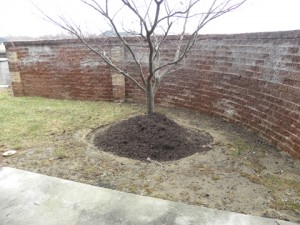It is truly amazing every single year how we continue to pile on the mulch. I’ve tried to analyze the mentality of this manic practice (specific evidently to the Washington area) like I’ve tried to get my mind around why someone would throw a piece of trash out a car window. What chronic disorder would possess people to invest hundreds of dollars and time on a seemingly ritualistic annual self-imposed duty?
Is it because the neighbors bought a truckload of mulch and are doing it? In other words ‘sheep syndrome’ or ‘neighbor envy’?
I know that nurseries make huge amounts of money encouraging the practice. So; great marketing, but on what basis? Granted that over-mulching is a number one contributor to death and decline in plants so it makes sense for a nursery to encourage this practice. It’s a win- win for them! Nurseries also sell a variety of edgings to hold your mulch in the beds!! Brilliant!!
A few years back I designed and installed a landscape for a stone yard to draw attention to the use of stone within a planted area. About 6 months later I went back to see how it had matured and was shocked to see that all the groundcover had been removed and the natural shapes of the plants had been tortured into tight balls; your typical gas-station variety. I asked the owner ‘What the ?” His reply was that no one could see the MULCH!!!!?? So; it IS about the mulch itself? Maybe this is really the reason as you can purchase a variety of interesting colors to display. So, why buy plants if it’s about the mulch?
Mulch is a by-product of the lumber industry. They had a problem disposing of the bark. Someone came up with the idea of redistributing it instead of hauling it away. This initially might have been a good idea but, somewhere along the line, it got way out of hand.
My understanding is that developers encourage mulching as a way to redistribute the clear-cutting methods they used in development. Piles of chipped trees were costly to remove. Why not make a profit with a campaign for necessity? Once I saw a Cadillac pulled over at a construction site on a Sunday with the driver shoveling a pile of left-over wood chips into the trunk; but I digress. Anyway, we’re now talking about wood chips which are even more detrimental to plantings.
Love the smell? Could it be a great way to get your hands dirty without getting really all that dirty? What else?
Let me tell you what the over-use of this by product DOES do.
- Over- mulching encourages surface rooting. Think about it. Roots are starved for air and water and climb, gasping to the surface, in an attempt to survive. Winter comes and the roots are in a loose medium that cannot protect them from winter freezes
- Mulch acts like a wick. In dry periods it sucks the water away from the roots and in wet periods it wicks water and holds it, providing an environment which encourages the growth of root rot, stem canker and a variety of other fungal organisms. Have you ever noticed a pile of what appears to be “dog vomit” on the top of your mulch? This is truly what it is called in the trade. I’ve seen it covering the branches of an azalea which, by the way, is one of the many fibrous rooted plants that suffer terminally from over-mulching. This “dog vomit” is the product of high humidity levels, irrigation systems or rain with mulch and can be deadly to plants. Plus, it’s gross.
- Over mulching raises magnesium levels in the soil causing a collapse of the structure of the soil leading to its inability to absorb and drain water. When the soil becomes wet it expands and when it dries out it gets very hard. This expands and contracts the root system. Rather than mulching year after year; cultivation would alleviate this condition.
- Mulch is anywhere from $25 – $50 per cubic yard. Plus labor and/or your time x 2 times per year…adds up over time.
As a contractor, I shouldn’t discount the business potential of mulching. I could get myself a truck-mount mulching rig and certainly reduce my recession stress. As a horticulturist, a recent graduate of the Watershed Academy (which included 6 months of sustainable awareness training), and as a responsible contractor, I won’t do it. In fact; once the initial planting installation is completed and mulched with 1” in groundcover areas and 2” in planting areas I can assure my clients that, as the groundcover establishes, their maintenance and watering will be reduce considerably, as will their maintenance cost.

If weeding is your concern; weed seeds root much easier in loose mulch than in soil and typically even arrive in the mulch. Groundcover helps hold water in the soil, chokes out weeds and is considered a ‘sustainable’ practice.
Here’s the depressing but unavoidable bottom line; the nurseries are jammed with people filling their trunks with bags of mulch. Homeowners, encouraged by the reasons above, are having truck loads of mulch delivered and installed this very moment. I have lectured, written and pleaded with homeowners about this topic for close to 30 years and those very same people will be the ones with over mulched beds yet another year.
To me; mulch mania falls in the same category with plant shearing, Round-up® mania and possibly, littering. People are still going to do it regardless. But, at least, I’ve made yet another attempt to reduce this practice.
